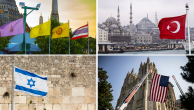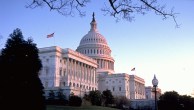Countries with the most extensive government restrictions
All 198 countries and territories in the study had at least some government restrictions on religious activity in 2020, such as policies favoring certain groups over others or bans on particular religious practices. But the severity of the restrictions and the means used to enforce them varied from country to country, and some countries consequently had much higher scores than others on the Government Restrictions Index (GRI). Those with higher GRI scores imposed a greater number of restrictions, enforced such restrictions more harshly, or did both.

In 2020, the number of countries with “very high” government restrictions fell from 23 to 19. This was the third year in a row the number of countries in this category decreased, bringing it to its lowest point since 2014.
Meanwhile, the number of countries with “high” levels of government restrictions rose from 34 in 2019 to 38 in 2020. This was the third consecutive year that the number of countries with “high” levels of government restrictions increased. Taken together, the number of countries with “high” or “very high” levels of government restrictions was the same in 2020 as in 2019 (57 countries), which matches the study’s highest total, also reached in 2012. (See Methodology for details on how the “high” and “very high” categories are determined.)
In 2020, five countries moved from the “very high” to the “high” government restrictions category. Three of them (Turkmenistan, Iraq and Sudan) had decreases of more than 1 point in their GRI scores, while Kyrgyzstan and Turkey had decreases that were less than 1 point.
There were different drivers behind these declines in scores. For example, in Sudan, where a constitutional declaration in 2019 (after the ouster of President Omar al-Bashir) included provisions protecting freedom of religious belief and worship, there were further expansions of religious freedom in 2020, including the repeal of a law making apostasy punishable by death and the revocation of laws allowing arrests for indecent dress or for offenses against “public morality.” In Turkmenistan, there had been reports in 2019 of campaigns in Ashgabat and Leban provinces to force men to shave their beards and mustaches (which were viewed as being associated with extremist tendencies), but no such campaigns were reported in 2020.
One country, Afghanistan, moved from the “high” into the “very high” government restrictions category in 2020, with an increase of less than 1 point. For a full list of all countries in each category, see the Government Restrictions Index in Appendix A.
Countries with the most extensive social hostilities
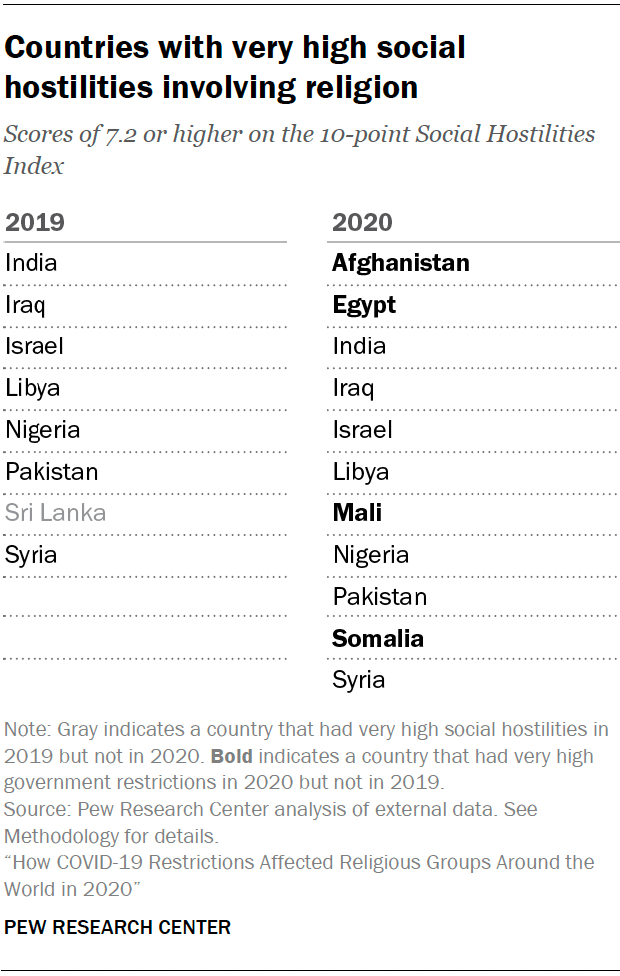
The Social Hostilities Index (SHI) captures a broad range of activities by private individuals and social groups, including but not limited to harassment and assault on people of particular faiths, mob violence against religious minorities, and terrorism carried out in the name of religion.
As has been the case in most years of the study, in 2020 there were fewer countries scoring “very high” on the SHI than on the GRI. The number of countries with “very high” social hostilities involving religion increased from eight in 2019 to 11 in 2020, while the number of countries with “high” levels of social hostilities dropped from 35 countries to 29. Overall, the number of countries with “high” or “very high” levels of social hostilities fell from 43 in 2019 to 40 in 2020.
Four countries – Afghanistan, Egypt, Mali and Somalia – moved from “high” to “very high” social hostilities in 2020. Most of these countries have moved between the “high” and “very high” categories over the course of the 13-year study, but this is Mali’s first time with very high social hostilities involving religion. There were reports in 2020 that extremist groups in Mali required all women to wear veils in the Mopti region of the country, while in the country’s Timbuktu region women were intimidated and threatened for not wearing veils. Mali did not have any such incidents over veiling in 2019, according to the sources used for the study. Egypt also had a reported incident involving a woman not covering her hair: In January 2020, a man in Cairo attacked a Christian woman with a knife and said he did so because she did not have her hair covered. (The attacker was subsequently arrested and referred to a psychiatric evaluation by the prosecutor.) Sources used for the study had not reported any similar incidents in Egypt in 2019.
In Somalia, the SHI score increased due in part to an attack by gunmen that killed five Quran teachers and injured others. The militant group al-Shabab also continued to regain territory and attacked government officials and their allies in the country.
One country, Sri Lanka, moved from the “very high” to “high” social hostilities category in 2020, partially due to fewer reported deaths that resulted from violent mob attacks. In 2019, there had been multiple days of mob attacks directed toward mosques and Muslim-owned businesses after the deadly ISIS-linked Easter Sunday bombings of that year, as well as at least one death owing to the mob violence. But in 2020, although there was mob violence resulting in assaults, there were no reported deaths. In addition, there were no religion-related terrorism incidents in Sri Lanka in 2020, according to the sources used for this study.
For the full list of countries in each category, see the Social Hostilities Index in Appendix B.
Changes in government restrictions on religion
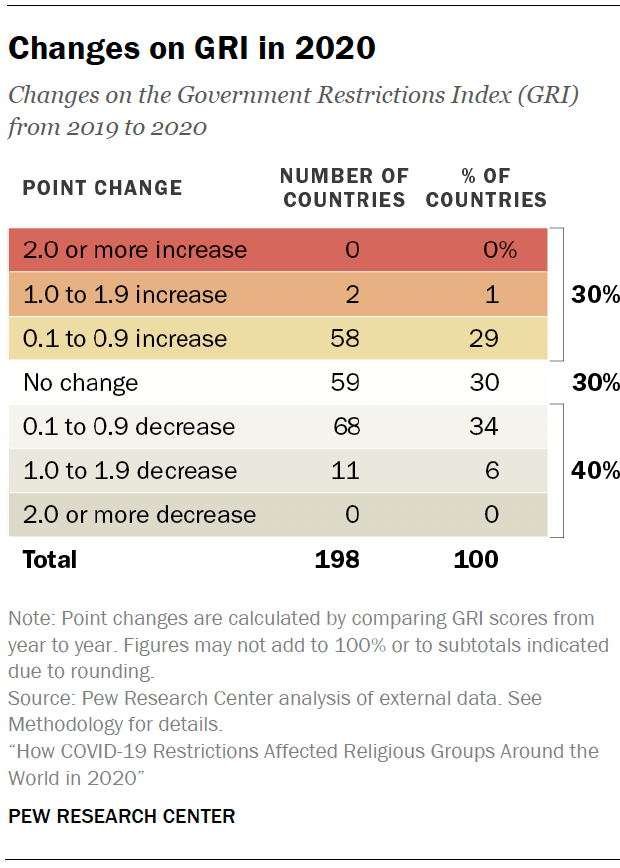
In 2020, 79 countries had decreases of 0.1 points or more in their GRI scores, while 60 countries had increases.
In 2020, no country in the study had a large change (2 or more points) in its GRI score. There were 13 countries with modest changes (1.0 to 1.9 points), including 11 decreases and two increases. Most countries – 126 in total, or 64% – had small changes (0.1 to 0.9), with 68 small decreases and 58 small increases in GRI scores. And 59 countries had no change in their GRI score.
Changes in social hostilities involving religion
When looking at social hostilities, six countries had large changes (2 or more points) in their SHI scores in 2020. Afghanistan had a large increase, while Benin, Central African Republic, Germany, New Zealand and Sierra Leone had large decreases. Thirty countries had modest changes (1.0 to 1.9 points), including 12 increases and 18 decreases, and 100 countries experienced small changes of 0.1 to 0.9 – 50 increases and 50 decreases.
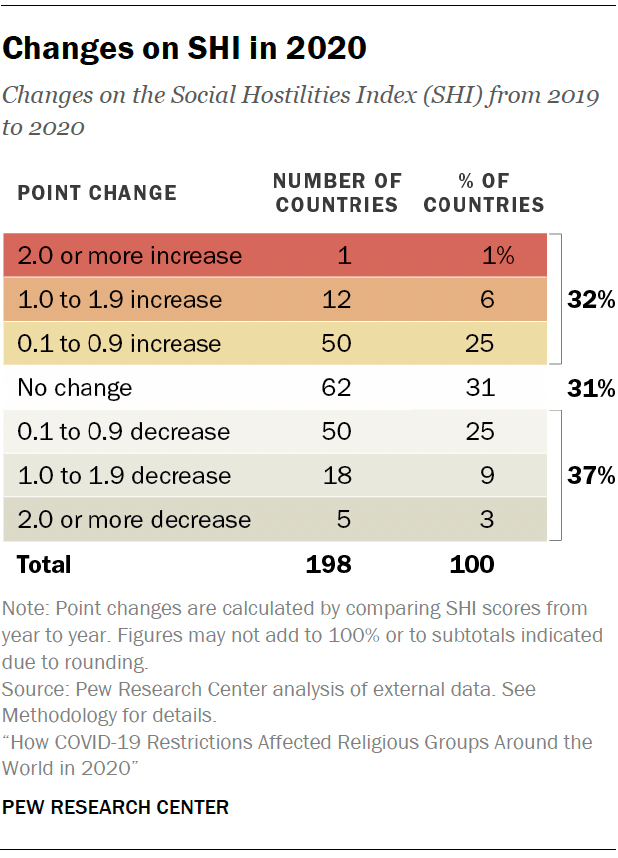
In Afghanistan – where 2020 saw continued fighting involving the Taliban, other armed groups, and the Afghan government in power at the time – the number of civilians killed or wounded declined from previous years, but targeted killings and abductions of government officials and politicians rose, according to Human Rights Watch. And throughout the year, religious minorities – particularly Sikhs – continued to be targets of deadly attacks that left their populations “near extinction” in Afghanistan, according to the U.S. Commission on International Religious Freedom. In March, a series of attacks targeting Sikhs killed 25 people and led around 200 Sikhs to leave Afghanistan for India, according to the U.S. State Department. (Deadly attacks against Sikhs in Afghanistan were not reported in 2019 in the sources used for this study.)
New Zealand’s score on the SHI went down in 2020 because it did not experience any terror attacks related to religion (that is, where a religious group was either the target or religion was a motivating factor). In 2019, the country had experienced an attack on two mosques in the city of Christchurch – the deadliest mass shootings in its modern history – after which the government formed an investigatory commission and pledged reforms to protect minority religious and ethnic groups.
In total, 62 countries had no change in their SHI score in 2020.
Changes in overall restrictions on religion
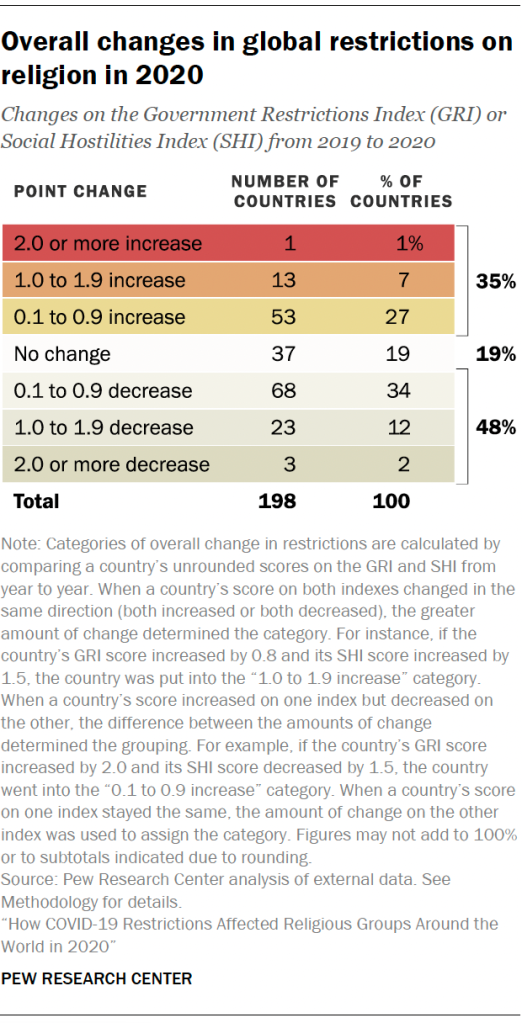
Combining government restrictions and social hostilities into a single measure, 67 countries had overall increases in their scores from 2019 to 2020, 94 had decreases, and 37 had no change. Of the countries with increases, there were 53 small upticks (between 0.1 and 0.9) and 13 with modest increases (1.0 to 1.9 change). One country, Afghanistan, had a large overall increase (2 or more points).
Among the decreases, 68 were small declines (0.1 to 0.9 change) and 23 were modest in scope (1.0 to 1.9). Three countries had large decreases in their overall scores (2 or more points): Central African Republic, New Zealand and Sierra Leone.


